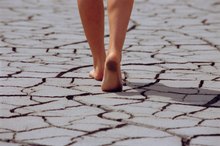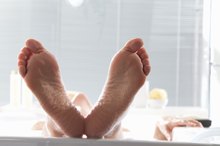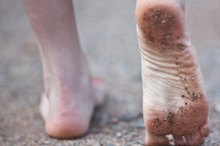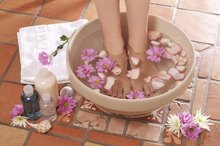What does fact checked mean?
At Healthfully, we strive to deliver objective content that is accurate and up-to-date. Our team periodically reviews articles in order to ensure content quality. The sources cited below consist of evidence from peer-reviewed journals, prominent medical organizations, academic associations, and government data.
The information contained on this site is for informational purposes only, and should not be used as a substitute for the advice of a professional health care provider. Please check with the appropriate physician regarding health questions and concerns. Although we strive to deliver accurate and up-to-date information, no guarantee to that effect is made.
How to Get Rid of Dead Skin on Feet
Dry, scaly feet are a common problem. Feet are subjected to daily abuse, from undergoing the pressure of walking to being exposed to the elements. You can remove dead skin from your feet by performing a nightly foot treatment at home.
This at-home dry skin foot treatment is not recommended for diabetics. Diabetics are susceptible to dangerous foot infections, and should treat dry skin and other foot conditions under medical supervision 1.
Soak and Scrub
Soak your feet in warm water for 20 minutes before bedtime to soften the dead skin.
Scrub the dead skin on your feet with a pumice stone, using gentle back-and-forth motions to remove the skin. A pumice stone is a porous volcanic rock you can buy in the foot care section of grocery stores, drugstores and beauty supply stores 23.
If you have a lot of dead skin on your feet, you won't be able to remove it all in one sitting. Remove as much as you can without causing pain; repeat the process again the next day.
Read more: How to Remove Calluses
Rinse, Rinse, Rinse
How to Fix Cracked Heels
Learn More
Rinse the dead skin off your feet under cool, running water.
Rinse the dead skin off the pumice stone under cool, running water. Place the pumice stone in an open area where it can air dry. Some pumice stones have a built-in loop attached to them, so you can hang them up to dry.
Dry and Apply Moisturizer
Pat your feet dry with a towel, and then massage generous amounts of foot cream onto your feet. Rub your fingertips in a circular motion along your feet, to rub in the cream and to promote blood circulation.
Purchase foot creams marketed for dry feet — these creams contain heavy moisturizers and ingredients to promote the shedding of dry skin cells, including vitamins A and E 23. Look for products recommended by the American Podiatric Medical Association 4.
Read more: Exfoliating Foot Creams
Wear Some Socks
How to Treat Cracked Diabetic Feet
Learn More
Put on a pair of cotton or wool socks to hold the moisture in your skin. In the morning, your skin should be smoother and more moisturized.
Read more: When to See a Podiatrist for Cracked Heels
Tips
If you do not have a pumice stone, use a washcloth instead.
Perform this home foot treatment every night until your feet are smooth and you no longer have dry skin.
Warnings
See a podiatrist if home treatment fails to relieve the dry skin on your feet.
Related Articles
References
- Living with Diabetes: Foot Complications
- Finding relief from calluses and corns
- Home Remedies for Corns and Calluses
- Seal of Acceptance/Approval Program from the American Podiatric Medical Association
- Institute For Preventive Foot Health. National Foot Health Assessment 2012. 2012.
- Boutrand LB, Thépot A, Muther C, et al. Repeated short climatic change affects the epidermal differentiation program and leads to matrix remodeling in a human organotypic skin model. Clin Cosmet Investig Dermatol. 2017;10:43-50. doi:10.2147/CCID.S120800
- Kapur S, Watson W, Carr S. Atopic dermatitis. Allergy Asthma Clin Immunol. 2018;14(Suppl 2):52. doi:10.1186/s13223-018-0281-6
- Safer JD. Thyroid hormone action on skin. Dermatoendocrinol. 2011;3(3):211-215. doi:10.4161/derm.3.3.17027
- Hashizume H. Skin aging and dry skin. J Dermatol. 2004;31(8):603-609. doi:10.1111/j.1346-8138.2004.tb00565.x
- Parker J, Scharfbillig R, Jones S. Moisturisers for the treatment of foot xerosis: a systematic review. J Foot Ankle Res. 2017;10:9. doi:10.1186/s13047-017-0190-9
- Linus Pauling Institute. (2012-2016). Oregon State University: Micronutrient Information Center: Essential Fatty Acids and Skin Health.
Writer Bio
Rose Kivi has been a writer for more than 10 years. She has a background in the nursing field, wildlife rehabilitation and habitat conservation. Kivi has authored educational textbooks, patient health care pamphlets, animal husbandry guides, outdoor survival manuals and was a contributing writer for two books in the Uncle John’s Bathroom Reader Series.









